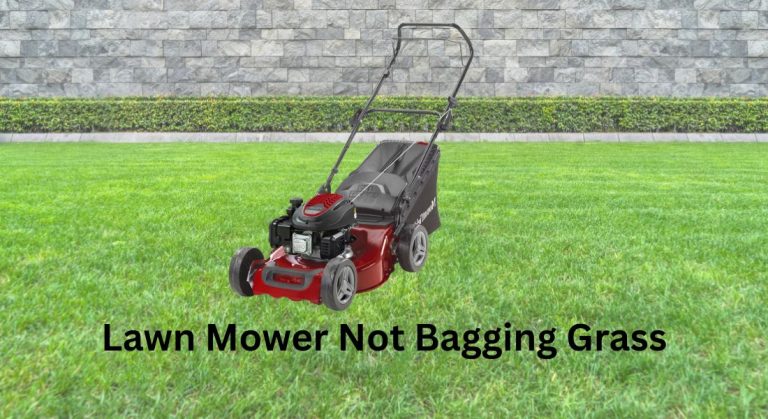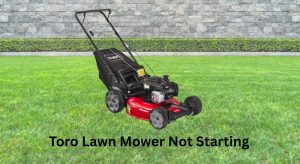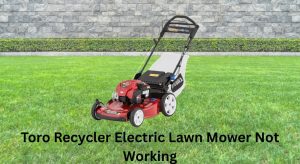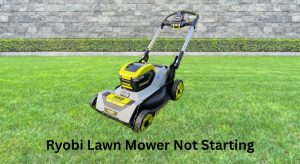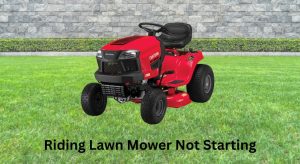If your lawn mower is not bagging grass, you’re likely dealing with clumps left behind, a half-full bag, or grass blowing out the chute. Frustrating, especially when you’re aiming for a clean finish. The fastest quick fix: raise your cutting height one notch, slow your walking pace, and ensure the bag is attached and seated properly. For many mowers, simply clearing the discharge chute and checking that the bag vents aren’t clogged will restore airflow and bagging.
Beyond the quick fix, this comprehensive guide covers the most common causes, step-by-step solutions for both push and riding mowers, and how to prevent bagging issues in the future. By the end, you’ll know exactly how to diagnose airflow problems, sharpen blades, set the right cutting height, fix deck clogs, and optimize your mower for clean, consistent bagging.
Common Causes of a Lawn Mower Not Bagging Grass

- Wet or overly long grass reducing airflow and clogging the chute
- Dull or incorrect blade (mulching blade used with bagging, or damaged blade)
- Clogged chute, mower deck, or bag filter/mesh vents
- Bag not seated correctly or damaged bag frame/underside
- Cutting height too low, causing grass to mat and block discharge
- Throttle set too low (engine RPMs too low to push clippings)
- Self-propel speed or walking pace too fast
- Deck packed with debris or caked-on grass reducing airflow
- Missing baffles or discharge door issues
- For riding mowers: Underpowered bagger/impeller or incorrect deck/bagger alignment
- For electric mowers: Overfilled or clogged bag, battery in ECO mode lowering blade speed
How to Fix a Lawn Mower Not Bagging Grass

Method 1: Restore Airflow with Quick Checks
Time: 10–20 minutes
Diagnosing the Issue
- Is the bag partially filling? Likely airflow restriction.
- Is grass clumping under the deck or chute? Clog or wet grass.
- Is the bag barely inflating? Low RPM, blocked bag vents, or dull blade.
Fix Steps
1) Power and Safety
– Gas mowers: Turn off engine, remove spark plug wire.
– Electric: Remove battery or unplug cord.
– Wait for blades to stop.
2) Empty and Inspect the Bag
– Empty the bag completely.
– Check the bag’s mesh/vents; knock off dust and grass from the outside.
– If caked, rinse the bag mesh inside-out with a hose and let it dry fully.
3) Clear the Discharge Chute and Deck
– Remove the bag. Inspect chute for clumps or stuck debris.
– Use a plastic scraper or stick to clear buildup under the deck (never use hands near blades).
– For heavy buildup, gently hose underside and let dry.
4) Check Bag Seating and Chute Door
– Reattach the bag fully onto the frame and hooks.
– Ensure the bag’s hard plastic collar seals around the discharge without gaps.
– Confirm the rear discharge door opens freely when the bag is installed.
5) Set Correct Height and Throttle
– Raise cutting height one to two notches.
– Set throttle to fast/full (avoid ECO mode on electric if bagging).
– Walk slower to let clippings clear into the bag.
Testing
- Mow a small test strip. Look for a fully inflating bag and consistent fill.
- If the bag still doesn’t inflate, proceed to blade and deck checks.
Method 2: Sharpen or Swap the Blade for Bagging
Time: 30–60 minutes
A sharp blade cuts cleanly into fine clippings that move easily into the bag. A dull or wrong-style blade leads to clumping and poor airflow.
Diagnosing the Issue
- Ragged grass tips or torn edges indicate dull blades.
- Using a mulching-only blade with bagging can hinder discharge.
- Bent or damaged blades reduce lift.
Fix Steps
1) Safety First
– Disconnect spark plug or remove battery.
– Tip mower with carb/air filter side up (for gas) to avoid fuel leaks.
2) Remove and Inspect Blade
– Use a block of wood to stop blade rotation.
– Loosen the blade bolt with a wrench.
– Inspect for nicks, bends, and worn “lift wings.”
3) Sharpen or Replace
– Sharpen both cutting edges evenly to about a 30-degree angle.
– File or grind in one direction; maintain balance (use a blade balancer or a nail-in-wall trick).
– If the lift wings are worn flat, replace with a high-lift or bagging blade designed for your model.
4) Reinstall
– Torque to manufacturer spec (commonly 35–60 ft-lbs for walk-behind mowers; check your manual).
– Ensure blade is installed right-side up (air lift wings face the deck).
Testing
- With a sharp high-lift blade, the bag should inflate quickly.
- If improvement is minor, continue to airflow and deck geometry checks.
Method 3: Deep Clean Deck, Improve Airflow, and Adjust Settings
Time: 30–45 minutes
Diagnosing the Issue
- Grass cakes on the deck after wet mowing.
- Bag fills slowly and chute clogs at bends.
- Deck interior looks rough/sticky.
Fix Steps
1) Deep Clean
– Scrape all caked grass from deck and chute.
– Wash underside. For stubborn residue, apply a biodegradable degreaser, wait 5–10 minutes, and rinse.
2) Dry and Coat
– Let the deck dry completely.
– Optional: Apply a dry silicone spray or graphite deck spray (avoid petroleum oils) to reduce buildup.
3) Adjust Cutting Height and Overlap
– Set mower height so you’re only removing one-third of grass blade length.
– Increase overlap between passes to keep clippings lighter.
4) Throttle and Speed
– Always mow at full throttle on gas models.
– Slow your self-propel speed one notch or walk slightly slower to improve bag filling.
5) Weather and Lawn Conditions
– Avoid mowing when grass is wet, dewy, or after heavy rain.
– If grass is very tall, perform a first pass at higher height, then lower and re-cut for bagging.
Testing
- After adjustments, the bag should inflate and fill evenly without clogging.
Method 4: Bagger System and Deck Alignment (Riding/Zero-Turn Mowers)
Time: 45–90 minutes
Riding mowers often use bagger kits with tubes and impellers. Poor alignment or air leaks kill performance.
Diagnosing the Issue
- Tube clogs near the deck discharge or bends.
- Bagging only works on short grass.
- Bags don’t inflate; impeller housing covered in debris.
Fix Steps
1) Inspect the Bagger Tube System
– Disconnect tubes; clear all bends.
– Check for cracks or gaps that leak air; replace damaged sections.
– Ensure tubes seat tightly with clamps or latches.
2) Check Impeller/Turbine (if equipped)
– Remove debris around the impeller housing.
– Spin by hand (engine off) to feel for binding.
– If impeller paddles are worn or chipped, replace.
3) Deck-Leveling and Pitch
– Park on flat ground. Level deck side-to-side.
– Set front-to-back pitch: front of deck about 1/8–1/4 inch lower than rear for better lift and discharge.
– Consult your model manual for exact specs (e.g., many 42–54 inch decks use 1/8–1/4 inch pitch).
4) Blades and Baffles
– Use high-lift “bagger” blades appropriate to your deck width.
– Verify internal baffles and discharge deflectors are present and secure.
5) Engine Speed
– Mow at full throttle. Reduce ground speed in heavy or tall grass.
Testing
- Run a short pass; look for strong airflow in the tube and inflating bags.
- If tubes still clog, consider optional powered blower/bagger upgrades compatible with your model.
Prevention Tips and Maintenance Advice
- Keep blades sharp: every 20–25 hours of mowing or 2–3 times per season.
- Avoid wet grass. Morning dew can be enough to clog baggers.
- Empty the bag before it’s completely full to maintain airflow.
- Clean the deck and chute after each mow if grass is damp or lush.
- Use a high-lift or bagging blade rather than a mulching blade when bagging.
- Store bags dry; wet bags trap fines and reduce airflow.
- Mow at full throttle and slower ground speed when growth is heavy.
- Follow the one-third rule: don’t remove more than 1/3 of the grass blade per pass.
Pro Tips
- Switch blades seasonally: mulching blade for mulching, high-lift blade for bagging.
- If your lawn is thick and damp, do two passes: first high, second lower for clean bagging.
- Lightly hose the bag exterior every few mows and let it fully dry to keep mesh clear.
- For cordless mowers, keep a spare battery and use “power” mode for bagging dense growth.
- Replace worn bag frames, stretched gaskets, or torn mesh—small leaks drastically cut bagging performance.
- Install deck washout fittings if available, and use after mowing to prevent buildup.
- Keep spare shear pins or blade bolts on hand to minimize downtime.
When to Call a Professional
- Persistent bagging issues after blade replacement and deck cleaning.
- Bent crankshaft or spindle causing uneven deck cut and poor discharge.
- Riding mower impeller or blower assembly damage.
- Deck welds, baffles, or hangers broken or misaligned.
- Carburetor or governor problems preventing full throttle on gas mowers.
- Electrical issues in cordless mowers limiting blade RPM.
What to look for:
– Certified small engine technician or dealer-trained service center.
– Experience with your brand/model.
– Transparent labor rates; typical shop rates range $75–$120/hour in many regions.
– Ask for blade torque specs, deck leveling measurements, and before/after cut test.
Warranty considerations:
– Using non-OEM baggers or blades may affect warranty. Check your owner’s manual before modifications.
– Keep receipts and document maintenance to support warranty claims.
FAQ
Q: Why does my mower bag work sometimes but clog on tall grass?
A: Tall or damp grass increases volume and moisture, which reduces airflow and causes clumping. Raise the cutting height, slow down, and ensure you’re using a high-lift blade. Consider a two-pass approach on overgrown areas.
Q: Can I bag with a mulching blade?
A: You can, but it’s not ideal. Mulching blades recirculate clippings and reduce discharge velocity. For best bagging performance, use a high-lift or bagging-specific blade recommended by your manufacturer.
Q: My bag isn’t inflating at all. What should I check first?
A: Verify full throttle, clean bag mesh, clear chute, proper bag seating, and a sharp high-lift blade. On electric mowers, disable ECO mode and ensure the battery is fully charged.
Q: Is it bad to mow wet grass if I’m bagging?
A: It’s not recommended. Wet grass clumps under the deck, clogs the chute, and weighs down the bag. If you must mow wet, raise the deck, go slower, and clean the deck immediately after.
Q: How often should I sharpen the mower blade for good bagging?
A: Every 20–25 mowing hours or at least twice per season. If you hit debris or notice ragged cuts, sharpen sooner.
Q: Why does the bag get dusty and stop filling well?
A: Fine dust and dried clippings clog the bag mesh. Rinse the bag inside-out and let it dry. Avoid overfilling, as packed clippings reduce airflow.
Q: Will a powered bagger or blower attachment help?
A: Yes, on many riding and zero-turn mowers, powered baggers significantly increase airflow and reduce clogging, especially in thick lawns. Ensure compatibility with your deck size and model.
Alternative Solutions
If bagging remains difficult due to lawn moisture, heavy growth, or mower design, consider these alternatives:
| Solution | Pros | Cons | Best For |
|---|---|---|---|
| Mulching with sharp mulching blade | No bags to empty; returns nutrients | Visible clippings in tall grass; needs dry conditions | Regular, frequent mowing |
| Side discharge then bagging second pass | Moves volume out first | Two passes; more time | Overgrown lawns |
| Lawn sweeper after side discharge | Collects debris efficiently | Extra equipment cost; storage | Large lawns, riding mower users |
| Gator/High-lift combo blades | Better lift and cut | May increase engine load; more noise | Dense, healthy turf with bagging |
Keep Your Lawn Mower Running Smoothly
Following this guide, you now have multiple solutions to fix your lawn mower not bagging grass:
– Quick airflow checks: clean bag mesh, clear chute and deck, seat the bag, run full throttle
– Blade fixes: sharpen or install a high-lift bagging blade
– Deck optimization: deep clean, adjust cutting height, slow pace, avoid wet mowing
– Riding mower alignment: clear tubes, check impeller, level deck, seal air leaks
Apply these steps in order, and you’ll restore strong airflow and consistent bagging, even in dense growth. With regular maintenance and the right blade, you’ll keep your lawn looking clean and professional.
Have you tried these methods? Share your results or your mower model in the comments for personalized advice. Found this helpful? Bookmark it for the next mowing season. Never deal with your lawn mower not bagging grass again—take control of airflow, blades, and mowing conditions for a spotless cut every time.

